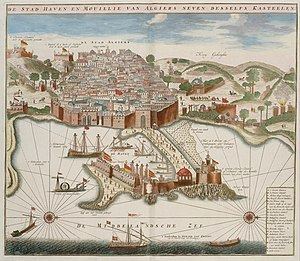Date 12 July 1784 | Result Decisive Allied victory | |
 | ||
Combatants Spain, Portuguese Empire, Kingdom of the Two Sicilies Similar Action of 28 Novembe, Spanish conquest of Oran, Siege of Melilla, Algiers expedition, Barbary Wars | ||
The 2nd Bombardment of Algiers took place between 12 and 21 July 1784. A joint Spanish-Neapolitan-Maltese-Portuguese fleet commanded by the experienced Spanish Admiral Antonio Barceló bombarded the city, which was the main base of the Barbary corsairs, with the aim of forcing them to interrupt their activities. Massive damage and casualties were inflicted to the Algerians, while the loss aboard the allied fleet was low. The Dey of Algiers refused to start negotiations immediately but the fear of a third planned expedition under José de Mazarredo convinced him to negotiate a peace with the Spanish by which he was forced to cease large-scale piracy, signalling the effective end of the Barbary privateering until the outbreak of the Napoleonic Wars.
Contents
Background
In August 1783, as punishment for the acts of piracy undertaken by the city, a Spanish fleet with Maltese participation under Antonio Barceló bombarded Algiers for 8 days. The success of the attack, achieved at the cost of less than 50 casualties, caused joy in Spain and encouraged the Regency of Tripoli to make peace with Spain. Despite the heavy damage suffered, the Algerians did not surrender. Five Algerian privateers captured two Spanish merchant vessels near Palamós in September 1783 as a gesture of defiance. The city's defenses were reinforced with a new 50-gun fortress, 4,000 Turkish volunteer soldiers were recruited in Anatolia, and European advisors were hired to assist in the building fortifications and batteries. In addition, at least 70 vessels were prepared to repel the Spanish, and a reward of one thousand gold pieces was offered by the Dey to anyone who captured a ship of the attacking fleet.
Meanwhile, in Cartagena, Barceló had finished preparations for a new expedition. His fleet consisted of four 80-gun ships of line, four frigates, 12 xebecs, 3 brigs, 9 small vessels, and an attacking force of 24 gunboats armed with pieces of 24 pounds, 8 more with 18 pounds' pieces, 7 lightly armed to board the Algerian vessels, 24 armed with mortars, and 8 bomb vessels with 8 pound pieces. The expedition was financed by Pope Pius VI and supported by the Navy of the Kingdom of the Two Sicilies, which provided two ships of the line, three frigates, two brigs and two xebecs under Admiral Bologna, by the Order of Malta, which provided a ship of line, two frigates and five galleys, and by that of Portugal, which provided two ships of line and two frigates under Admiral Ramirez Esquivel. These last joined the allied fleet later and arrived in the middle of the bombardment.
Bombardment
On 28 June, having entrusted itself to the Virgen del Carmen, the Allied fleet sailed from Cartagena, arriving off Algiers on 10 July. Two days later at 8:30 AM, the bombardment began with the Spanish ships opening fire. It was kept up until 4:20 PM, during which time about 600 bombs, 1,440 cannon balls and 260 shells were fired over the city, compared to 202 bombs and 1,164 cannonballs fired by the Algerians. Major damage to the city and its fortifications and a large fire were observed. An attack by light vessels of the Algerian fleet, composed of 67 ships, was repulsed, four of them being destroyed. The Allied casualties were minimal: 6 killed and 9 wounded, most of them due to accidents with the fuses of the bombs. Gunboat No. 27, commanded by the Neapolitan ensign José Rodríguez, exploded accidentally, killing 25 sailors.
In the following eight days, seven additional attacks were ordered. The Algerians had placed a line of barges armed with artillery that largely prevented the Allied gunboats getting close to their objectives. A shot fired from the fortifications hit the felucca from which Barceló were directing the bombing, sinking it. José Lorenzo de Goicoechea came to the aid of the admiral, who was rescued unscathed. Passing immediately to another boat, Barceló continued leading the attack, downplaying the importance of the incident. Finally, on 21 July, it was decided to end the attack. Contrary winds forced Barceló to give the order to return to Cartagena. More than 20,000 cannonballs and grenades had been fired on the enemy, causing severe damage to the fortifications and the city, and sinking or destroying most of the Algerian vessels. The Allied casualties were 53 men killed and 64 wounded, most of them due to accidents.
Aftermath
The Dey of Algiers, under threat of a new expedition that was already being prepared by Barceló, who had promised attack Algiers every year until he accepted his conditions, agreed to open negotiations with Spain. These culminated in a treaty which was signed on 14 June 1786 by the Dey himself and José de Mazarredo, who came to Algiers in command of a squadron of two ships of the line and two frigates. Tunisia also preferred to reach an agreement with Spain. As far as these nations were concerned, Barbary piracy and the Barbary Slave Trade in the Mediterranean was ended. However, some years later the problem returned due to the turmoil caused by the Napoleonic Wars.
